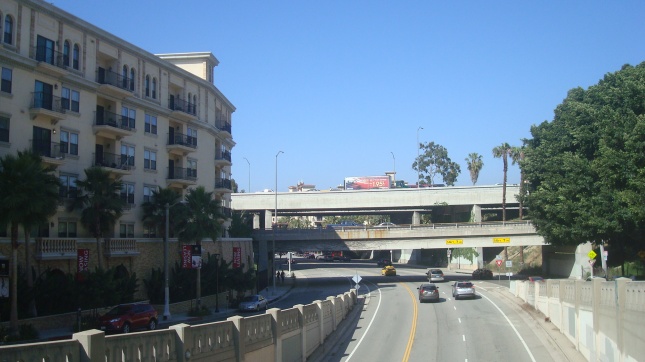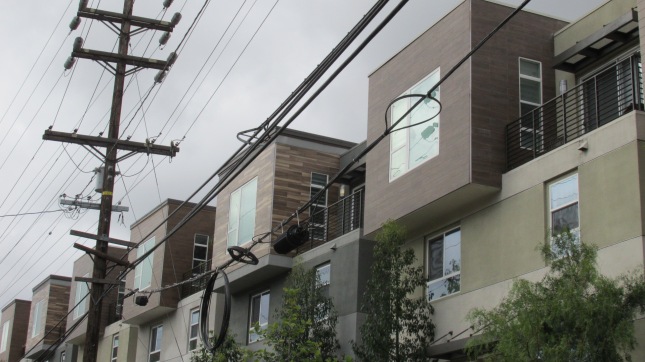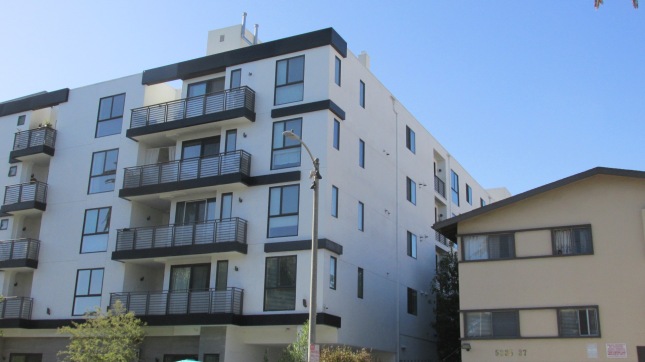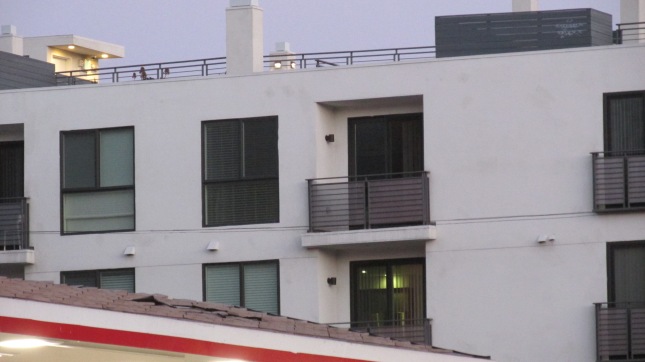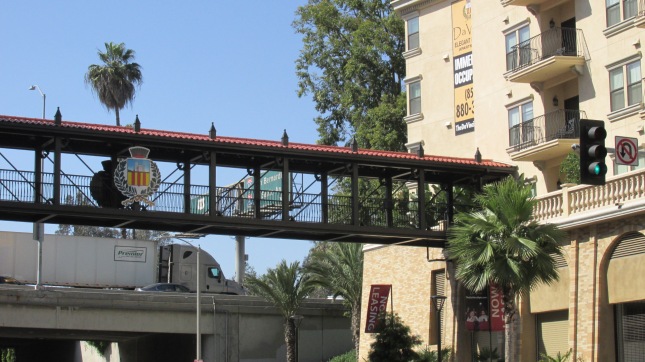
Site at Vermont and Redondo where Prologis wants to build a massive distribution center.
Back in February I was at a City Planning Commission (CPC) hearing. I’d come to talk about one of the items on the agenda, but while I was waiting for that to come up, I noticed a group of people sitting together holding signs that said “NO on 7”. These people wanted to voice their opposition to a new distribution center that had been proposed for their community. Logistics REIT giant Prologis was seeking permission to build a 341,000 sq. ft. warehouse with 36 truck loading positions and parking for up to 71 trailers that would operate 24/7. Amazingly, the site they had in mind was right across the street from a residential neighborhood in the Harbor Gateway area.

The community shows their opposition at the City Planning Commission hearing.
A long list of speakers got up to talk. First there were the applicants and their reps, all of whom boasted about what a great project this was. There were also a number of union members who came forward to tell the Commissioners that the distribution center would create lots of jobs. And staff from Councilmember Joe Buscaino’s office showed up to speak in support of the project.
But the people who actually live in the community were dead set against it, talking about impacts from diesel truck exhaust, and noise from a distribution center that was going to operate 24/7. They explained to the Commissioners that the site was just across the street from apartments and houses. They pointed out that a healthcare facility, a convalescent home and a public park were all within a few hundred feet of the proposed distribution center. The CPC listened to all this, and then voted to approve the project. While Commissioners Vahid Khorsand and Veronica Padilla-Campos voted against, everyone else gave the distribution center a thumps up, and it passed easily. The final tally was 6-2.

Residential neighborhood directly across the street from the project site.
Even though I’d never heard of the project before that morning, it was pretty easy to see that the approval process was a joke. The applicant wants to build a 300,000+ sq.ft. warehouse right across the street from a residential neighborhood. The warehouse will generate hundreds of diesel truck trips every day, and will operate all night long. This is a project that will have major impacts on the surrounding community, but instead of doing a full Environmental Impact Report (EIR), the Department of City Planning (DCP) allowed the applicant to slide it through with a much less rigorous Mitigated Negative Declaration (MND). In other words, the DCP is saying that even though there could be negative impacts, don’t worry about it, because we can mitigate them to the point where they won’t be a problem.

Kei-Ai Healthcare Center sits just across the street from the project site.
It’s a familiar game. The City of LA plays it all the time. The DCP lets the applicant run the environmental review process without providing any meaningful oversight. DCP staff will offer some suggestions, the CPC will set some conditions, but the project that gets approved generally gives the developers pretty much everything they were asking for. These days most of the Commissioners on the CPC seem to believe their job is to approve projects. No matter what’s being proposed, the routine is pretty much the same. They listen to testimony, ask DCP staff a few questions, spend a little time haggling over conditions, and then give it a green light. Occasionally, as with this distribution center, one or two of the Commissioners will dissent, but almost without exception the majority gives the proposed project a thumbs-up and the developers and their reps walk out smiling.

Gardena Convalescent Center is just over a block away from the project site.
But the people who live in the neighborhood aren’t smiling. And they’re not taking this lying down. I contacted one of the residents, Rosalie Preston, to ask if the community was planning to fight the project. She sent me a copy of the appeal they’d submitted. Preston points out that the community is already considered disadvantaged by the California Environmental Protection Agency (CalEPA) because of its proximity to the 110. The freeway carries hundreds of diesel trucks through the area every day, causing CalEPA to rank it in the highest percentile for pollution burden.
I really hope the appeal will be granted, because the community has already spent way too much time opposing this awful project. But if the appeal is denied and this goes to court, I’ll be laughing my head off on the day the judge hands the City of LA another embarrassing defeat. The City has lost a number of high-profile cases related to development and planning. This will just be one more demonstration of how badly broken the approval process is.
But let’s take look at the appeal, and see why the community has a problem with the CPC’s decision to approve the project….
An EIR, Not an MND
There’s really no question about this. According to State law, an EIR is required if “substantial evidence in the record supports a fair argument that the project may result in significant adverse impacts.” The Prologis Distribution Center will bring hundreds of diesel trucks in and out of this residential community, all through the day and all through the night. Prologis argues that they can mitigate air quality and noise impacts to the point where they’re not significant. It’s not surprising to hear developers make idiotic claims like this, but it’s depressing that the City is happy to take their word for it. The fact that the DCP allowed Prologis to get away with an MND shows just how little they care about how new development impacts LA’s communities.
Toxic Emissions
Diesel trucks emit a range of harmful substances, and the claim that hundreds of trucks will travel through this community every day without having significant impacts on the health of the residents is absurd. Among the components of diesel exhaust are particulate emissions. The California Air Resources Board (ARB) regulates two classes of particulate emissions.
PM2.5: Up to 2.5 microns in size.
PM10: Up to 10 microns in size.
The ARB web site offers this information….
“The ARB is concerned about Californians’ exposures to PM2.5- and PM10-sized particles because of the potential harmful health effects that can result. PM 2.5 and PM10 particles easily penetrate into the airways and lungs where they may produce harmful health effects such as the worsening of heart and lung diseases. The risk of these health effects is greatest in the elderly and the very young. Exposure to elevated concentrations of PM is also associated with increased hospital and doctor visits and increased numbers of premature deaths.”
The consultants who wrote the MND claim that the PM levels residents will be exposed to fall within the limits set by ARB, but the appeal calls this into question. To predict the emissions that will be generated by a proposed project, environmental consultants use a program developed by the State known as CalEEMod. The appellants looked at the numbers used by the authors of the MND for these estimates, and then compared them to the numbers actually given in the MND. “When we reviewed the Project’s CalEEMod output files, we found that several of the values inputted into the model were not consistent with information disclosed in the IS/MND.” The appellants believe that the numbers used by Prologis’ consultants represent only about half of the truck trips the project would generate. This means the actual levels of PM pollution would be double, and the health impacts to the community much more severe than Prologis has stated.
Site Clean-Up
It’s known that former industrial uses on the site left toxic chemicals in the soil, including tetrachloroethylene (a likely carcinogen), trichloroethene (a known carcinogen), total petroleum hydrocarbons and heavy metals. A Phase I Environmental Site Assessment was done in 2016. It concluded that the site was rife with contaminants and recommended additional investigation. Anybody with common sense should understand that there’s no way to talk about mitigating the impacts until all the information is available.
The appeal covers a lot of other issues, but it all boils down to the fact that Prologis isn’t being honest about the impacts that will be caused by the project. And as usual, the Department of City Planning and the City Planning Commission are letting the developer get away with it. There’s certainly an argument to be made regarding the jobs the project will create, and the increase in economic activity throughout the area. But even if the CPC believes the economic benefits outweigh the health concerns, they’re still required by law to fully assess the impacts and to make every reasonable effort to protect the health of the community. They haven’t done that. By allowing Prologis to use an MND instead of an EIR, they’ve let the developer off the hook and let the community down.
But that’s nothing new. Anybody who’s been following development in LA over the years knows about the cozy relationship that business interests have with City Hall, and by extension, with the DCP. Developers and real estate investors know it’s just a matter of working the machine, and if they play the game right, pretty much anything they ask for will be approved.
City Hall is supposed to protect us. Instead they’re selling us out. The people opposing this project are just the latest victims of the City’s disrespect for State-mandated environmental review. By allowing Prologis to slide through this process without properly assessing the project’s impacts, the DCP is putting residents’ health at risk.
That’s not acceptable. Unfortunately, once again the CPC has ignored the law, and once again residents have been forced to pursue an appeal and possibly a law suit just to protect their community. Once again the City of LA has put the interests of developers over the rights of citizens.

Rosecrans Recreation Center, directly north of the project site. Photo by Carmelita Ibarra from Google Images.

